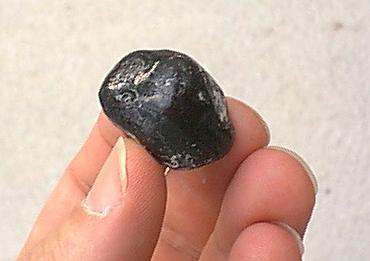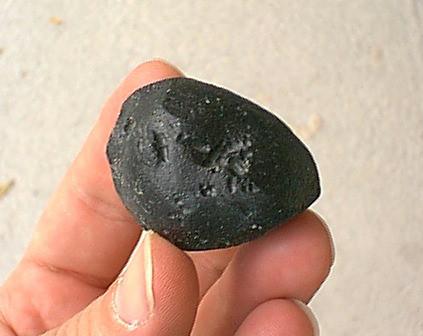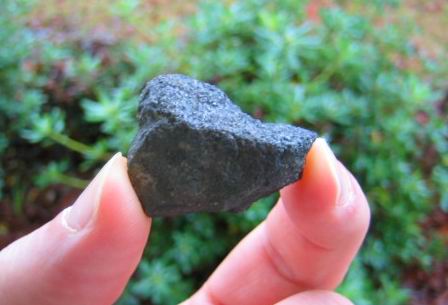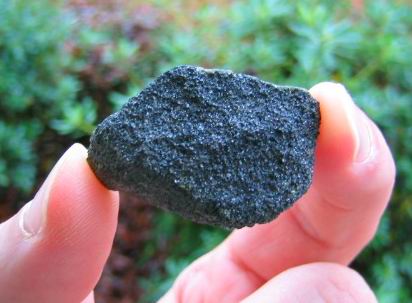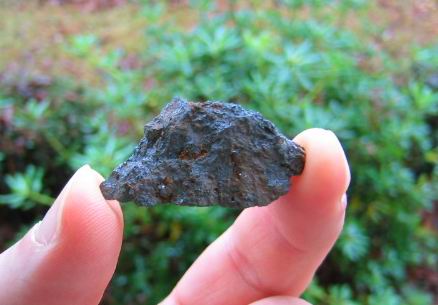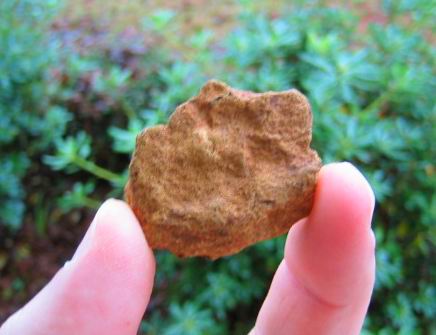
|
|||
|
|
||
Based
simply upon casual observation, see if you can tell the |
|
|
|
Here is an
easy one. Tektites are pieces of natural glass which are created when
|
|
Correct
Answer: The one on
the right
is the tektite. |
. .
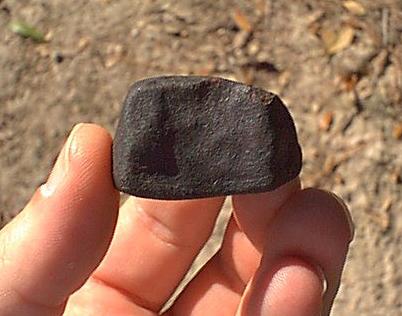 |
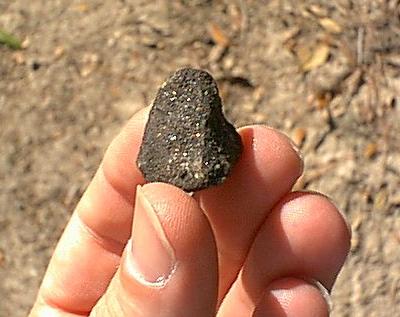 |
Here is one
that is slightly harder (but not too hard). |
|
Correct Answer:
The one on
the left is the meteorite. |
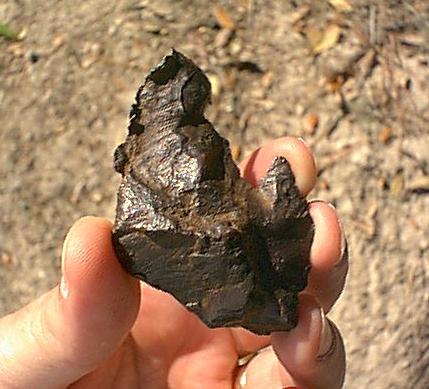 |
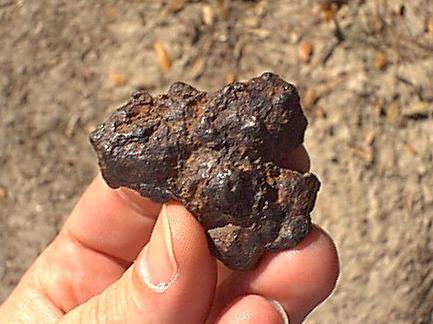 |
Here is one that
is harder than the others. |
|
from the Sikhote-Alin fall of 1947. The one on the right is a piece of slag (interesting looking, but not a meteorite)! Now, take a look at the following four images. Which one is the real meteorite? |
|
|
|||
|
|
| Well, which is it (scroll down to see the answer)? |
Actually, none of
these are meteorites! |
| Well, how did
you do! If you suspect that you have a meteorite, first do some preliminary "analysis." Does it have a dark, oftentimes "glassy" fusion crust as an outer covering? Meteorites develop this crust as material is ablated off during passage through the Earth's atmosphere. The presence of such a crust-like material strongly indicates a meteorite, while the absence of a crust strongly indicates a meteor"wrong." However, it should be noted that meteoites found in the "hot deserts" usually do not exhibit a dark fusion crust, due to terrestrial weathering. Also, because of the iron content, the overwhelming majority of meteorites respond to a magnet (particularly if it is an iron meteorite!). If there is no pull when a magnet is placed against the suspected stone, it probably is not a meteorite. As well, a true meteorite will be much heavier than a similiar sized terrestrial rock. Now, if the suspected stone passes the above tests, it might be a meteorite! IMCA does not have the facilities to test suspected meteorites but we would suggest that you contact one of the meteorite verification laboratories listed below. |
Note: Send only a small (walnut size - if possible) sample(s). Testing may take a month to a year depending
upon the backlog of the facility.
METEORITE TESTING AND CLASSIFYING INSTITUTIONS
| U.S. Cascadia Meteorite Labratory Department of Geology Portland State University P.O. Box 751 Portland, OR 97207-0751 Telephone: (503) 725-3372 Fax: (503) 725-3025 ruzickaa@pdx.edu http://meteorites.pdx.edu/ http://meteorites.pdx.edu/possible-met.htm New England Meteoritical Services (NEMS) P.O. Box 440 Mendon, MA USA 01756 Instructions and Pricing E-mail: staff@meteorlab.com Voice: 508-478-4020Fax: 508-478-5104 Dr. Timothy J. McCoy mccoy.tim@nmnh.si.edu Linda Welzenbach Welzenbach.Linda@nmnh.si.edu Department of Mineral Sciences NHB 119 Smithsonian Institution Washington, DC 20560 call before sending sample: (202) 633-1825 Professor J. T. Wasson Dr. Alan E. Rubin Institute of Geophysics University of California Los Angeles, California 90095-1567 USA Dr. Denton S. Ebel debel@amnh.org Department of Earth & Planetary Sciences The American Museum of Natural History Central Park West at 79th St. New York, NY 10024 Dr. Edward R. D. Scott escott@kahana.pgd.hawaii.edu Hawaii Institute of Geophysics & Planetology School of Ocean and Earth Science Technology University of Hawaii Honolulu, HI 96822 Dr. Derek W. Sears meteor@comp.uark.edu cosmo@cavern.uark.edu Cosmochemistry Group Department of Chemistry & Biochemistry University of Arkansas Fayetteville, AR 72701 Dr. Michael Zolensky michael.e.zolensky@jsc.nasa.gov NASA/Johnson Space Center Mail Code SN2 Houston, TX 77058 Dr. David A. Kring kring@gamma1.lpl.arizona.edu Lunar and Planetary Laboratory University of Arizona 1629 East University Blvd. Tucson, AZ 85721 Director - Dr. Carleton Moore cmoore@asu.edu Center for Meteorite Studies Department of Chemistry & Biochemistry Arizona State University Box 872504 Tempe, Arizona 85287- 2504 1-480-965-6511 fax 1-480-965-2747 Catherine Nicole Foley nfoley@fieldmuseum.org (312) 665-7656 Meenakshi Wadhwa wadhwa@fieldmuseum.org Meteorite Catalog (pdf - large) The Field Museum of Natural History S. Lake Shore Dr. Chicago, Illinois 60605 Dr. Randy Korotev Washington University 1 Brookings Dr Campus Box 1169 Saint Louis MO 63130-4899 what_to_do |
Other Canada - The Prairie Meteorite Search http://www.geo.ucalgary.ca/PMSearch/ contact page Dr. Monica M. Grady M.Grady@nhm.ac.uk Mineralogy Department The Natural History Museum Cromwell Road London SW7 5BD, United Kingdom Planetary Sciences Research Institute Open University Milton Keynes MK7 6AA, UK Become a Meteorite Hunter Museum National d'Histoire Naturelle Jardin des plantes Grande Galerie de l'Evolution Paris, France Dr. Brigitte Zanda meteor@mnhn.fr Muséum National d'Histoire Naturelle 61, rue Buffon 75005 Paris, France Dr. Gero Kurat Gero.Kurat@univie.ac.at Naturhistorisches Museum Postfach 417 A-1014 Vienna, Austria Addi Bischoff bischoa@uni-muenster.de Dr. Dietmar Weber weberd@mail.uni-muenster.de Institut fuer Planetologie Wilhelm-Klemm-Str. 10 48149 Muenster, Germany Phone: ++49 (251) 8333465 Home: ++49 (2597) 5258 FAX: ++49 (251) 8339083 Dr. Dieter Stoffler stoffler@museum.hu-berlin.de Museum fur Naturkunde Invalidenstrasse 43 D-10115 Berlin, Germany Max-Planck-Institut fur Chemie Saarstrasse 23 55020 Mainz, Germany Institut fur Mineralogie und Geochemie Universitat zu Koln Zulpicherstrasse 49b 50674 Koln, Germany      |

